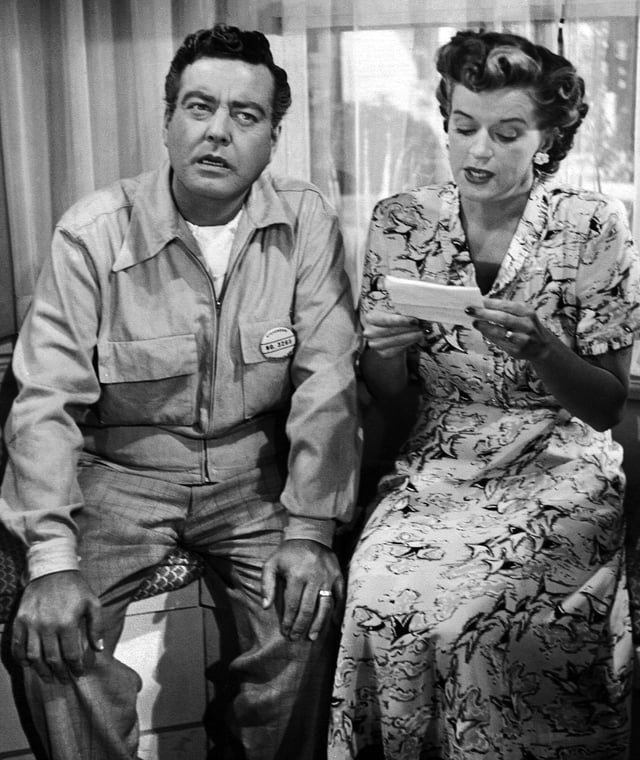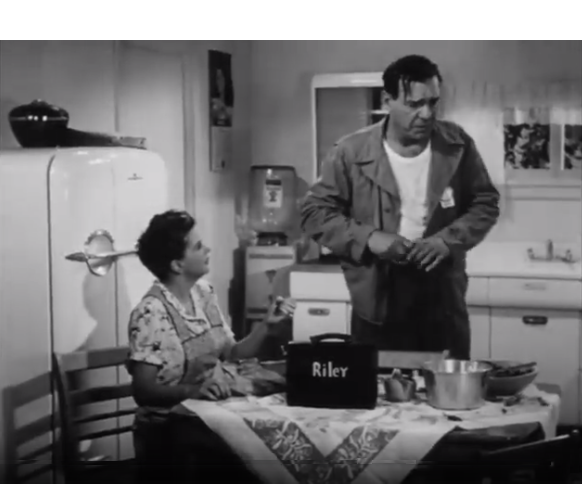Possibly the earliest surviving TV sitcom is The Life of Riley starring Jackie Gleason which aired on NBC from October 4, 1949 to March 28, 1950 (Wikipedia). The entire series was filmed and all 26 episodes are available on DVD.

The Life of Riley, Jackie Gleason, Rosemary DeCamp 1949
The British sitcom Pinwright’s Progress which aired ten episodes beginning in November 1946 is generally considered the first TV sitcom. However it was broadcast live and no recordings were made (British Comedy Guide).
And as you mentioned Mary Kay and Johnny, which also was broadcast live and which first aired in 1947, seems to have only one surviving episode. As a side note the Paley Center in New York has public access to their archives on video screens, with a daily admission fee. The Los Angeles museum is currently closed. You can see the listing for Mary Kay and Johnny in the online Paley library database.
Similar to music and variety shows, most TV sitcoms in the late 1940’s and into the early 1950’s were still broadcast live, even after westerns and some other types of programs had begun using film. Videotape did not exist, the only recording method for live broadcasts was kinescope, which was essentially a film camera pointed at a studio monitor during the live broadcast. Although dedicated kinescope equipment was used, the quality of this process was very limited.

Kinescope (source: Canada Museum of Science & Technology via Wikimedia Commons CC BY-SA 3.0)
Kinescope was used primarily for repeating live broadcasts in other time zones. Kinescope quality was generally not good enough to be used extensively for reruns in syndication, thus very few kinescopes of that era have survived. After their initial use there was really no need to keep them, and maintaining them in warehouses would have been an unnecessary expense. The few that have survived have mostly come from private collections, this includes the estimated 350 surviving DuMont kinescopes, out of 20,000 programs that were broadcast on DuMont from 1946 to 1955 (Wikipedia).
One of the survivors was most of the Jackie Gleason Honeymooner sketches on Gleason’s variety show on DuMont in the early 1950’s and then on CBS, because Gleason reportedly received kinescope copies of his programs as a stipulation of his contract, which he kept in a warehouse until releasing them to DVD in the early 2000’s. Meanwhile the one-season The Honeymooners sitcom in 1955 was filmed, and all 39 of those episodes have survived.
An earlier U.S. sitcom The Goldbergs has partially survived. The Goldbergs was initially broadcast live and debuted in January 1949 on CBS, then went to NBC in 1952, then DuMont in 1954. In 1955 it began filming episodes for syndication. Apparently only some of the DuMont episodes and the later syndicated episodes survive. A similar situation seems to exist for two other 1949 sitcoms, Mama on CBS, and The Aldrich Family on NBC.

The Goldbergs
Sitcom producers initially avoided using film because the single-camera method then in use, similar to filming a movie, made it impractical to have a studio audience present during filming. In fact The Life of Riley initially aired without laughter. Although when it was later distributed in syndication a laugh track was added to the episodes. Early filmed sitcoms in the early 1950’s were sometimes shown to audiences in a theater, and the laughter recorded. However this often did not give the desired result, either there was not enough laughter, or laughs lasted too long and drowned out dialogue. The invention of the laugh track machine, basically a collection of recorded laughter, created the ability to enhance the audience laughter, a process known as "sweetening", which was actually used well into the 2010's, even for shows filmed in front of an audience.
In 1950 the U.S. sitcom The Hank McCune Show debuted. Besides being an early single-camera filmed sitcom, it is regarded as being the first sitcom to rely solely on a laugh track (Wikipedia). By the early 1950’s sitcoms had for the most part abandoned live studio audiences, as nearly all sitcoms had switched to filming single camera using laugh track machines only. This situation continued through the 1960’s and well into the 1970's. Among the few exceptions was I Love Lucy which was filmed in front of a studio audience using three cameras. Contrary to popular belief Desi Arnaz did not invent this method, it had been used before, however it was apparently the first time that it was used with a live audience. Other Desilu shows such as Our Miss Brooks also used three camera with an audience. As did the 1955 sitcom version of The Honeymooners, and the 1960's sitcom The Dick Van Dyke Show.
In the 1970's most sitcoms began to be filmed or videotaped in front of a live audience. Although in recent years there has been a move back to filming without an audience, and with no laugh track at all. So The Life of Riley turned out to be a pioneer in more ways than one.
Whether with canned laughter or not the use of film for sitcoms, apparently beginning with The Life of Riley, ensured that most sitcoms from that point forward, even the most obscure, have been accessible to future generations. And in many cases they are now seen in much better quality than what TV audiences experienced during their initial broadcasts, when the programs were viewed on small, somewhat blurry television sets.
As for The Life of Riley, contrary to popular belief it was not cancelled due to low ratings, but instead ended after one season because of a dispute with the show’s sponsor who wanted to take advantage of recently obtained rights to televise boxing matches. There was a reboot of the series in 1953 starring William Bendix who had starred in the 1940's radio version and the 1949 movie. Due to being under movie contract at the time he was not available in 1949 for the first run of the TV series.

The Life of Riley, William Bendix
As a side note, the unaired pilot for The Life of Riley that was filmed in 1948 starred Lon Chaney Jr. of Wolf Man fame as Riley, along with Rosemary DeCamp who also appeared with Gleason in the broadcast version. DeCamp is perhaps better known as Marlo Thomas's mother in the 1960's sitcom That Girl, as well as Shirley Jones's mother in the 1970's sitcom The Partridge Family.

The Life of Riley pilot episode, Lon Chaney Jr., Rosemary DeCamp 1948





